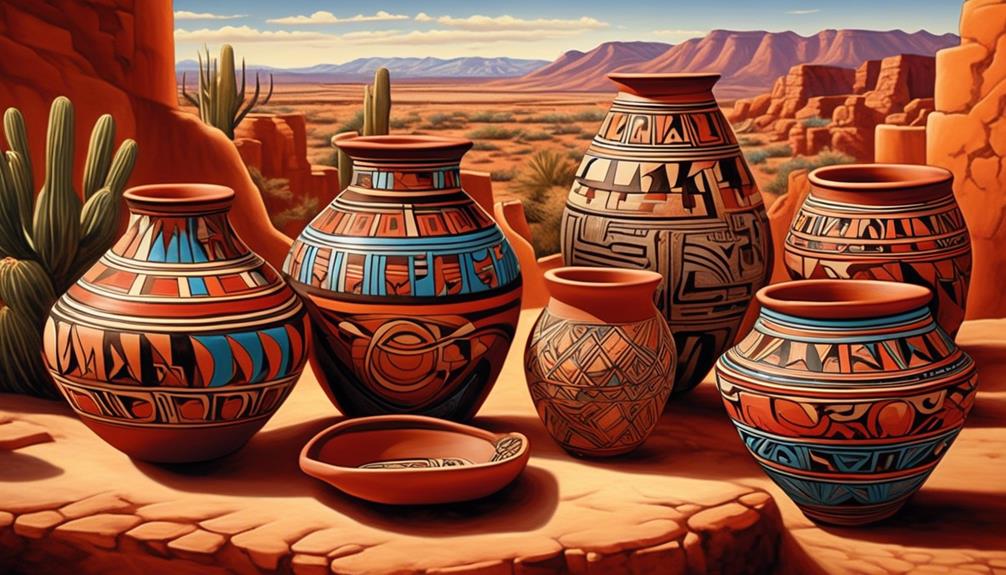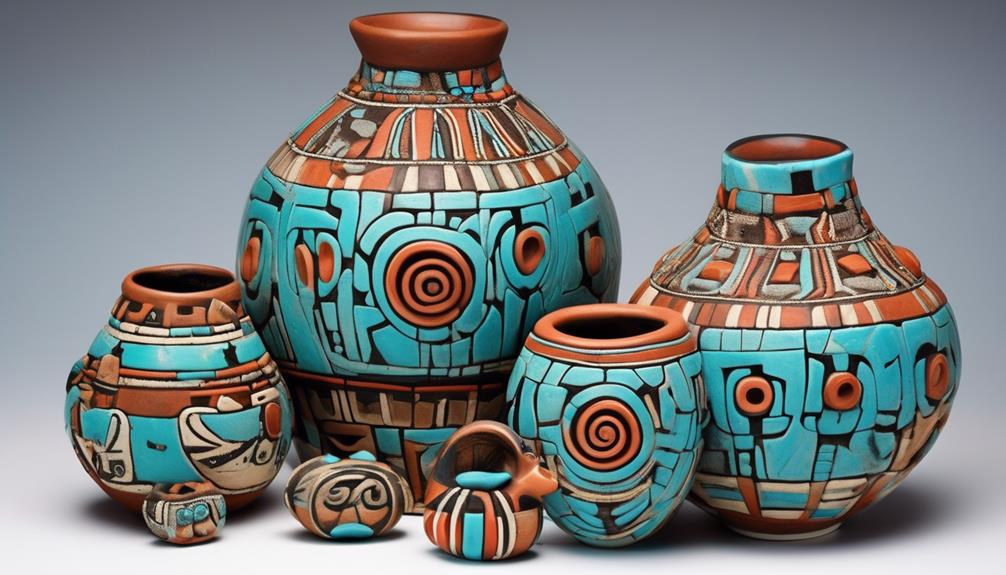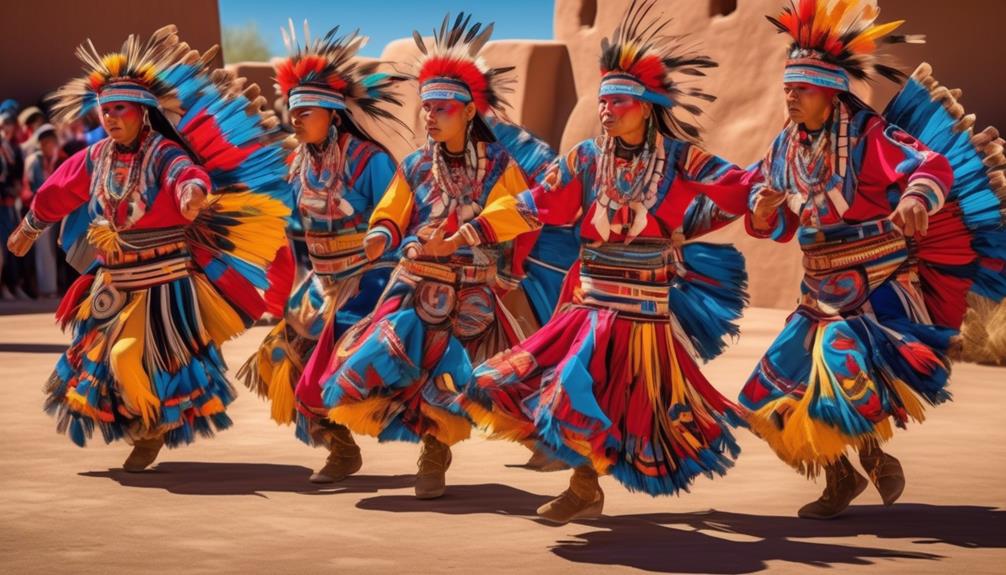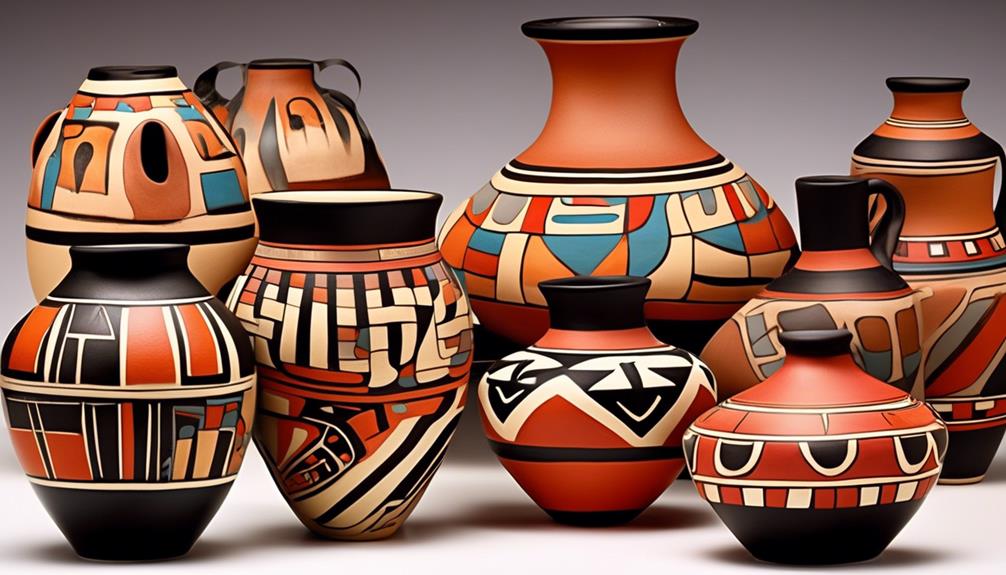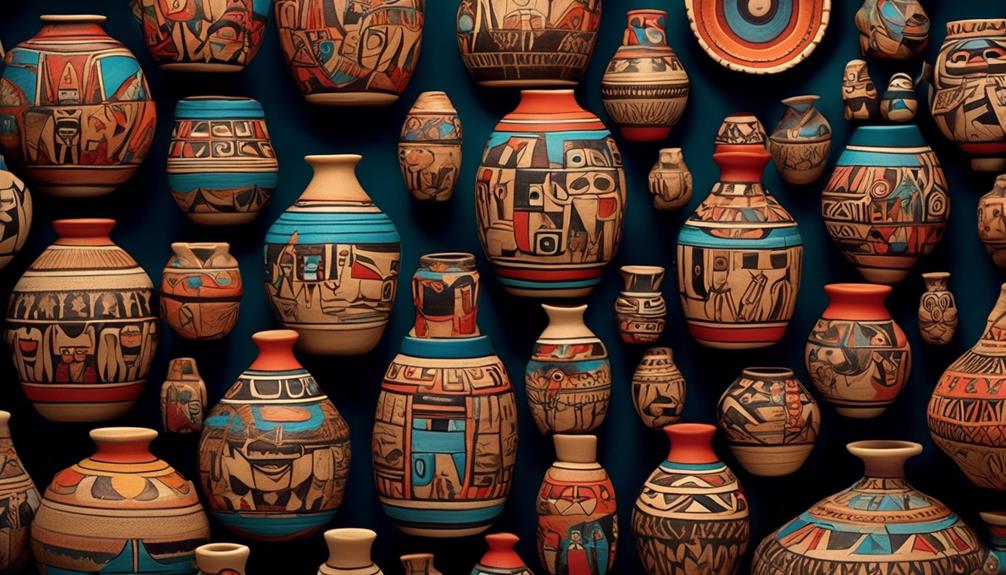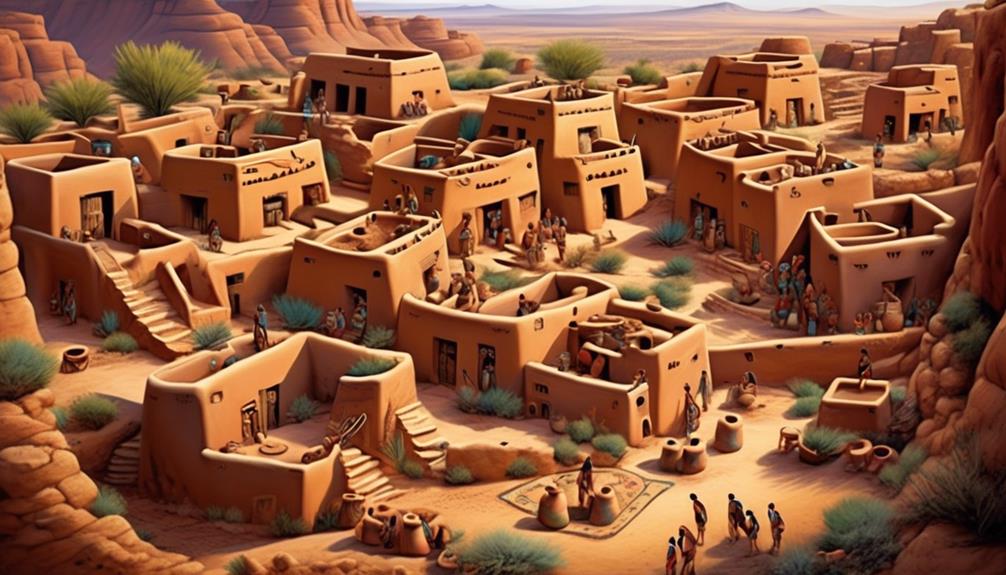The Hopi Native American Tribe possesses a distinctive cultural identity with a captivating and extensive history. Despite facing numerous challenges, they have demonstrated perseverance and resilience over time.
Their traditions and beliefs are deeply rooted in their daily lives, and their art and crafts are a reflection of their vibrant culture. However, there is much more to the Hopi Indian Tribe than meets the eye.
Their way of life and their customs hold a sense of mystery and intrigue that beckons us to explore further.
Key Takeaways
- The Hopi Indian Tribe has ancestral roots in ancient Puebloan cultures and has inhabited the region for over a thousand years.
- They have a deep connection to the land and a profound respect for nature, as well as a strong sense of community and the importance of community gatherings.
- The Hopi Indian Tribe has a rich cultural heritage with various ceremonial rituals, including Katsina dances, Powamu ceremony, Niman ceremony, and Soyal ceremony.
- Their art, pottery, and crafts are intricate and vibrant, reflecting their spiritual beliefs and conveying narratives of creation and migration.
Origins and History
The origins and history of the Hopi Indian Tribe can be traced back through oral traditions, archaeological evidence, and historical records, providing a rich tapestry of their cultural heritage. The Hopi people are believed to have ancestral roots in the ancient Puebloan cultures of the American Southwest. Archaeological evidence suggests that their ancestors inhabited the region for over a thousand years, leaving behind intricate cliff dwellings and pottery that offer insights into their way of life.
The migration patterns of the Hopi are also a significant aspect of their history. According to oral traditions, the Hopi people journeyed through the desert guided by prophetic signs, eventually settling in the mesas of northeastern Arizona. This migration is deeply woven into the fabric of Hopi identity, shaping their spiritual beliefs and cultural practices.
Studying the ancestral roots and migration patterns of the Hopi Indian Tribe reveals the depth of their connection to the land and the enduring traditions that have been passed down through generations. The preservation of these traditions continues to be a cornerstone of Hopi cultural identity.
Traditional Way of Life

Journeying through the desert guided by prophetic signs, our ancestors settled in the mesas of northeastern Arizona, where the traditional way of life of the Hopi Indian Tribe reflects a deep connection to the land and enduring cultural practices. The Hopi people continue to uphold their traditional way of life, which is characterized by a profound respect for nature and a strong sense of community.
Community Gatherings: The Hopi community places great importance on coming together for various events such as dances, feasts, and rituals. These gatherings strengthen the bonds among tribe members and provide opportunities for sharing knowledge and traditions.
Spiritual Ceremonies: Central to the Hopi way of life are spiritual ceremonies that are deeply rooted in their beliefs and traditions. These ceremonies, often held in kivas, are conducted to honor the deities, seek blessings for the community, and ensure the well-being of the tribe.
Cultural Preservation: The Hopi tribe actively works to preserve their traditional way of life by passing down oral histories, maintaining agricultural practices, and adhering to ceremonial protocols. The elders play a crucial role in teaching the younger generations about the customs and values that define the Hopi way of life.
Cultural Practices and Beliefs
Rooted in centuries-old traditions and beliefs, the cultural practices of the Hopi Indian Tribe encompass a rich tapestry of ceremonial rites and agricultural customs. Ceremonial rituals play a central role in the Hopi way of life, serving as a means of connecting with their ancestors and the spiritual realm. These rituals are meticulously passed down through generations, preserving the tribe's deep spiritual connection to the land and the cosmos. The Hopi people believe that their ceremonies ensure the balance and harmony of the natural world, making them vital to the prosperity of their community.
—
| Ceremonial Rituals | Spiritual Connection | Agricultural Customs |
|---|---|---|
| Katsina dances | Communion with ancestors and deities | Dry farming techniques |
| Powamu ceremony | Renewal of the world | Cultivation of corn, beans, and squash |
| Niman ceremony | Prayer for rain and abundant harvests | Water conservation practices |
| Soyal ceremony | Welcoming the winter solstice | Seed preservation methods |
| Wuwutcim ceremony | Honoring the Earth Mother | Sustainable land management |
—
Art, Pottery, and Crafts
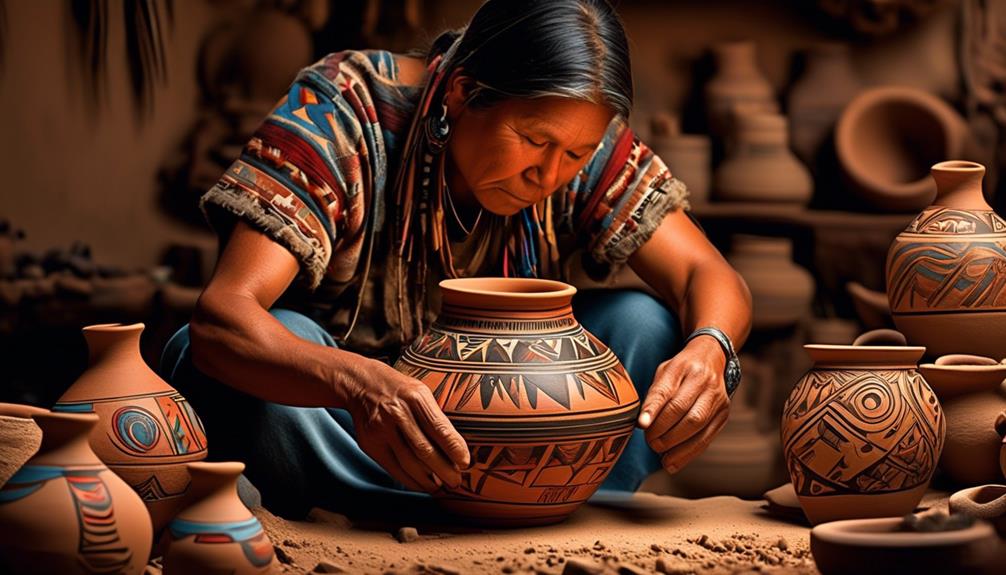
Creating intricate designs and vibrant patterns, the Hopi Indian Tribe demonstrates their artistic prowess through their pottery, art, and crafts. These creations are deeply rooted in tradition and hold significant cultural symbolism, often telling stories of the Hopi people and their connection to the land.
The tribe's artwork is a reflection of their spiritual beliefs and serves as a means of passing down these beliefs to future generations. Traditional techniques are meticulously preserved and passed down through apprenticeship, ensuring the continuity of artistic heritage. Despite this dedication to tradition, modern influences have also made their mark, leading to innovative designs that blend traditional motifs with contemporary elements.
The art, pottery, and crafts of the Hopi Indian Tribe serve as a visual language, conveying narratives of creation, migration, and ceremonial rituals. The intricate patterns and symbols adorning their creations reveal the deep spiritual connection the Hopi people have with the natural world.
Through their artwork, the Hopi Indian Tribe preserves their cultural identity and imparts their rich heritage onto the world.
Contemporary Challenges and Preservation
In addressing contemporary challenges and preservation, the Hopi Indian Tribe strives to balance the preservation of traditional artistic techniques with the evolving influences of the modern world.
Cultural adaptation is a key aspect of this balancing act, as the tribe seeks to honor its heritage while also embracing the opportunities and challenges of the present day.
The preservation of traditional artistic techniques, such as pottery-making and weaving, is central to maintaining the Hopi cultural identity. However, in the face of globalization and changing societal dynamics, the tribe is also working to empower its community members to adapt and thrive in the modern world while upholding their cultural heritage.
One way the Hopi Indian Tribe is addressing contemporary challenges is through community empowerment initiatives. These efforts focus on providing the necessary support and resources for community members to preserve and pass on traditional artistic techniques, while also encouraging innovation and adaptation to contemporary artistic trends.
Frequently Asked Questions
How Does the Hopi Indian Tribe View the Concept of Time and History?
We understand the Hopi views on time and history as integral to their cultural preservation. The concept of time is cyclical, reflecting the interconnectedness of all things.
Their historical perspective emphasizes the importance of maintaining traditions and language. Sovereignty challenges have prompted the Hopi to assert their rights and protect their cultural heritage.
This approach underscores the resilience and determination of the Hopi people in preserving their identity and traditions.
What Are Some Lesser-Known Traditional Ceremonies and Rituals of the Hopi Indian Tribe?
Traditional ceremonies and ritual practices of the Hopi Indian Tribe encompass a wide array of lesser-known but deeply significant cultural traditions. These include the Niman Kachina ceremony, the Powamu ceremony, and the Wuwuchim ceremony.
These rituals are vital in maintaining the tribe's spiritual and cultural identity, often involving intricate dances, music, and symbolic performances that connect the Hopi people with their ancestors and the natural world.
Can You Provide Examples of Specific Symbols and Their Meanings in Hopi Art and Pottery?
Absolutely!
Hopi symbols in art and pottery are rich with meaning, reflecting the tribe's deep cultural identity. Each symbol, from the rain cloud to the katsina figure, holds significant spiritual and cultural significance.
Hopi pottery and art preservation face challenges, yet the tribe continues to honor and pass down these symbols, keeping their traditions alive.
Understanding the meanings behind these symbols provides a window into the profound and enduring heritage of the Hopi people.
How Does the Hopi Indian Tribe Approach the Preservation of Their Language and Oral Traditions in Contemporary Society?
In contemporary society, the Hopi Indian tribe prioritizes language revitalization and cultural preservation through innovative storytelling techniques.
Contemporary language education is integral to preserving their oral traditions.
Through community-led efforts, the tribe utilizes modern tools and methods to ensure the continuity of their language and traditions.
This approach reflects the tribe's commitment to maintaining their unique cultural identity and heritage in today's world.
What Are Some Unique Challenges the Hopi Indian Tribe Faces in Preserving Their Cultural Identity and Sovereignty?
Preserving Hopi cultural identity is challenging due to external influences and modernization.
The tribe faces difficulties in maintaining language, traditional practices, and sovereignty. Cultural preservation is vital for our community's well-being.
The tribe works to protect sacred sites, language, and ceremonies. Upholding tribal sovereignty is crucial for self-governance and preserving our way of life.
These challenges require ongoing efforts to maintain our cultural heritage and traditions.
Conclusion
In conclusion, the Hopi Indian tribe continues to face contemporary challenges while striving to preserve their rich cultural heritage.
Like the resilient pottery they create, the Hopi people are shaped by their traditions and beliefs, standing strong and resilient in the face of adversity.
As they continue to navigate the complexities of the modern world, they remain steadfast in their commitment to preserving their unique way of life for future generations.
Mary is a passionate writer who brings creativity and a fresh perspective to our team. Her words have the power to captivate and inspire, making her an essential contributor to our content. Mary’s commitment to storytelling and dedication to promoting Indigenous culture ensures that her work touches the hearts of our readers. We’re fortunate to have her as part of our team.
